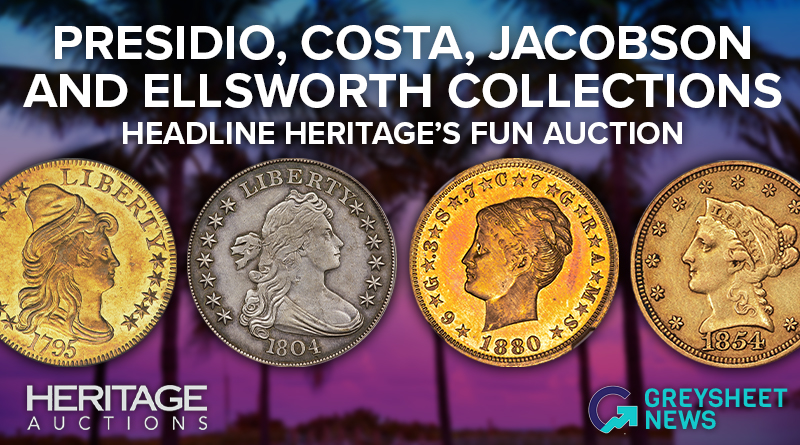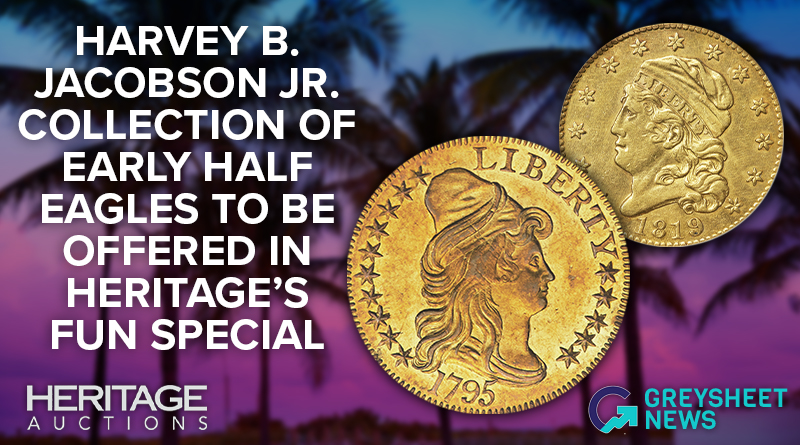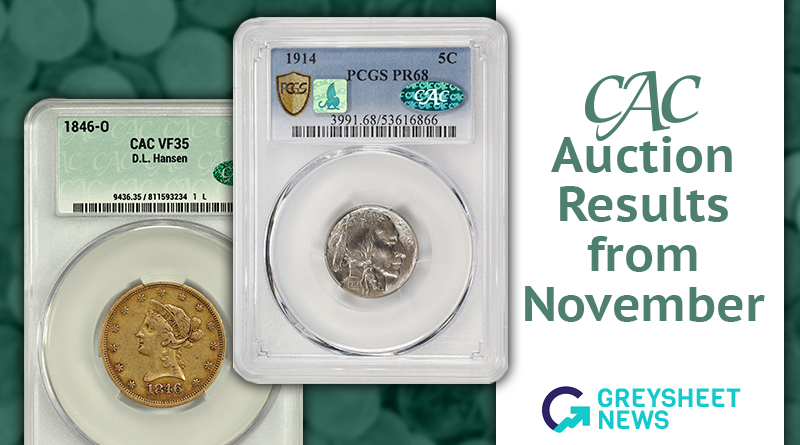Greysheet & CPG® PRICE GUIDE
- U.S. Coins /
- Pattern Coinage /
-
Patterns (1858) Values
About This Series
History and Overview
1858 was a “very good year” in terms of patterns, as by this time the numismatic community was dynamic, societies had been formed, and there was an eager market for interesting specimens. At the same time, the Mint was displeased with the Flying Eagle cent design used in circulation since 1857, as deep parts of the obverse die, particularly the head and tail of the eagle, were opposite in the coining press from deep parts of the reverse die, specifically the wreath, with the result that the features of the eagle were often lightly struck up.
A new pattern combining an Indian Head obverse with a laurel wreath reverse (J-208) was the one to be used for circulation. The design went into official use the next year.
Several different obverse and reverse dies were prepared, apparently mostly in the autumn. In addition, regular dies of the 1858 year were used to create patterns. The various dies involved can be described as follows:
Cent Obverse Dies of 1858
Obverse 1: “Flying Eagle in plain field.” Flying eagle die, but without inscription or date. • Used with J-219.
Obverse 2: “Flying Eagle, Large Letters, no date.” Regular Flying Eagle cent die, Large Letters, UNITED STATES OF AMERICA above, but no date. • Used with J-201, J-219.
Obverse 3: “Flying Eagle, Small Letters, no date.” Regular Flying Eagle cent die, Small Letters, UNITED STATES OF AMERICA above, but no date. • Used with J-200.
Obverse 4: “Flying Eagle, Large Letters, regular die.” Regular Flying Eagle cent die, Large Letters, UNITED STATES OF AMERICA above, date 1858 below. • Used with J-196 to J-199, J-218, J-218a.
Obverse 5: “Flying Eagle, Small Letters, regular die.” Regular Flying Eagle cent die, Small Letters, UNITED STATES OF AMERICA above, date 1858 below. • Used with J-191 to J-195, J-217, J-217a. Also J-362 of 1864.
Obverse 6: “Small Flying Eagle.” Small or “skinny” flying eagle, UNITED STATES OF AMERICA above, date 1858 below. • Director Snowden called this “a small eagle, volant, presented in a different position from that on the legal cent.”12 • Used with J-202 to J-207a, J-220.
Obverse 7: “Indian Head, no date.” Indian Head, but no date. UNITED STATES to the left, OF AMERICA, to the right. • Used with J-214 to J-216.
Obverse 8: “Indian Head.” Indian Head cent as adopted in 1859 (two portrait varieties: style with narrow bust point as adopted in 1859, and style with rounded bust point as mostly used on patterns of 1858), UNITED STATES to the left, OF AMERICA, to the right, date 1858 below. • Several die varieties exist. • The rounded bust style was the most popular for use on 1858 patterns; in 1860 it reappeared on regular issue cents. The pointed bust was less often used on 1858 patterns and was the standard style for regular 1859 cents. • Used with J-208 to J-213, J-220.
Cent Reverse Dies of 1858
Reverse A: “Regular die with agricultural wreath.” “Agricultural wreath” as used on regular issue Flying Eagle cents of the year. • There are two main styles of reverse:13 the “High Leaves” and the “Low Leaves.” • Used with J-201, J-206 to J-207a, J-213, J-217 to J-218a.
Reverse B: “Oak wreath.” Oak wreath with arrows below, tied with ribbon, open at top ONE CENT at the center. • Used with J-192, J-197. J-200, J-203, J-211.
Reverse C: “Oak wreath with ornamented shield.” Oak wreath with arrows below, tied with ribbon, ornamented shield at wreath apex, ONE CENT at the center. “The objection to this was that the shield had the appearance of a harp.”14 Sometimes called ornamental shield. • Used with J-193 to J-195, J-198, J-199, J-204. J-205, J-212, J-216.
Reverse D: “Laurel wreath.” Laurel wreath with ONE CENT at the center, variously described in Mint correspondence as “laurel” or “olive,” tied with ribbon below. This die was later used on the regular issue cent of 1859. Variations in wreath details exist, the most notable being either five or six leaves in each cluster. Most 1858 patterns had five leaves (and with the wreath slightly off center); a few had six leaves (with the wreath centered) as did all regular issue 1859 cents.15 • Used with J-191, J-196, J-202, J-208 to J-210, J-214, J-215.
The preceding designations are useful in listing the various combinations made in 1858. Examples existing in larger numbers today, Rarity-4 or Rarity-5, are those that were included in 12-piece sets made up at the Mint and sold to numismatists. These sets included three obverse dies (Obverses 5, 6, and 816) combined in each instance with Reverses A through D17. Of these 12 coins, the combination of Obverse 5 with Reverse A yielded a regular issue (1858 Small Letters Proof striking) and thus is not listed among patterns today.
In addition, many other pattern cents, probably most of them, were sold individually here and there to collectors and dealers. As can be seen from the die combinations, most of these were probably conceived for use to sell to the numismatic trade. Not only were pieces struck in 1858, but also these became a stock in trade item for years thereafter. J-208, the well-known 1858 transitional Indian Head cent with reverse of 1859, seems to have been a particularly popular variety, and several die varieties exist. How late such restrikes were made is anyone’s guess, but it is likely that production continued for years afterward.
A quarter dollar pattern was made this year, employing the regular Liberty Seated die for the obverse and, on the reverse, a new version of a perched eagle, attributed to Anthony C. Paquet. Pattern half dollars dated 1858 were also made from a regular obverse die and a reverse die by Paquet, the last featuring an eagle with a shield on its breast and a ribbon across the shield. Paquet also tried his hand at making a pattern gold dollar, similar to that in current use, but with the lettering in a taller font.
Collecting Perspective
Pattern cents of the year 1858 form a playground for numismatists, and in time, most of them can be collected, this being particularly true of those designated as R-4, R-5, and even R-6. Specialists with a technical turn of mind can investigate certain die variations and states, most notably with Obverse 8 and Reverse D described above.
Generally, pattern cents of this year were struck from dies with at least a partial prooflike surface, although some dies were made in haste and had numerous striae. Deep full-mirror Proofs are in the minority, and when found, are most likely to be the Flying Eagle obverses, either the regular-issue style (after Gobrecht) or the Small Flying Eagle. Additional strikings of certain combinations and metals were produced in very small numbers, designated as R-7 and R-8 today, and were not widely sold to collectors at the time.
The pattern quarter dollars and half dollars of 1858 with the Paquet reverse are scarce, and pieces appear on the market only occasionally. Whether these were actually struck in 1858 or, more likely, struck a year or two later but using an 1858 obverse die, is not known. The Paquet gold dollar is likewise elusive.
Catalog Detail
Legal Disclaimer
The prices listed in our database are intended to be used as an indication only. Users are strongly encouraged to seek multiple sources of pricing before making a final determination of value. CDN Publishing is not responsible for typographical or database-related errors. Your use of this site indicates full acceptance of these terms.

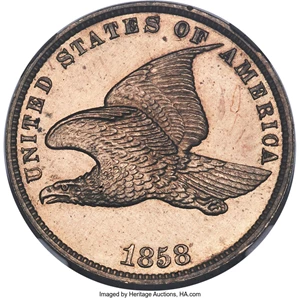


















From the Greysheet Marketplace
Buy Now: $3,695.00
Buy Now: $2,890.63
Buy Now: $120,000.00
Buy Now: $38,900.00
Buy Now: $5,500.00
Buy Now: $37,000.00
Buy Now: $3,121.88
Buy Now: $37,000.00
Buy Now: $31,500.00
Buy Now: $125,000.00
Related Stories (powered by Greysheet News)
View all news
Greysheet Catalog Details
History and Overview
1858 was a “very good year” in terms of patterns, as by this time the numismatic community was dynamic, societies had been formed, and there was an eager market for interesting specimens. At the same time, the Mint was displeased with the Flying Eagle cent design used in circulation since 1857, as deep parts of the obverse die, particularly the head and tail of the eagle, were opposite in the coining press from deep parts of the reverse die, specifically the wreath, with the result that the features of the eagle were often lightly struck up.
A new pattern combining an Indian Head obverse with a laurel wreath reverse (J-208) was the one to be used for circulation. The design went into official use the next year.
Several different obverse and reverse dies were prepared, apparently mostly in the autumn. In addition, regular dies of the 1858 year were used to create patterns. The various dies involved can be described as follows:
Cent Obverse Dies of 1858
Obverse 1: “Flying Eagle in plain field.” Flying eagle die, but without inscription or date. • Used with J-219.
Obverse 2: “Flying Eagle, Large Letters, no date.” Regular Flying Eagle cent die, Large Letters, UNITED STATES OF AMERICA above, but no date. • Used with J-201, J-219.
Obverse 3: “Flying Eagle, Small Letters, no date.” Regular Flying Eagle cent die, Small Letters, UNITED STATES OF AMERICA above, but no date. • Used with J-200.
Obverse 4: “Flying Eagle, Large Letters, regular die.” Regular Flying Eagle cent die, Large Letters, UNITED STATES OF AMERICA above, date 1858 below. • Used with J-196 to J-199, J-218, J-218a.
Obverse 5: “Flying Eagle, Small Letters, regular die.” Regular Flying Eagle cent die, Small Letters, UNITED STATES OF AMERICA above, date 1858 below. • Used with J-191 to J-195, J-217, J-217a. Also J-362 of 1864.
Obverse 6: “Small Flying Eagle.” Small or “skinny” flying eagle, UNITED STATES OF AMERICA above, date 1858 below. • Director Snowden called this “a small eagle, volant, presented in a different position from that on the legal cent.”12 • Used with J-202 to J-207a, J-220.
Obverse 7: “Indian Head, no date.” Indian Head, but no date. UNITED STATES to the left, OF AMERICA, to the right. • Used with J-214 to J-216.
Obverse 8: “Indian Head.” Indian Head cent as adopted in 1859 (two portrait varieties: style with narrow bust point as adopted in 1859, and style with rounded bust point as mostly used on patterns of 1858), UNITED STATES to the left, OF AMERICA, to the right, date 1858 below. • Several die varieties exist. • The rounded bust style was the most popular for use on 1858 patterns; in 1860 it reappeared on regular issue cents. The pointed bust was less often used on 1858 patterns and was the standard style for regular 1859 cents. • Used with J-208 to J-213, J-220.
Cent Reverse Dies of 1858
Reverse A: “Regular die with agricultural wreath.” “Agricultural wreath” as used on regular issue Flying Eagle cents of the year. • There are two main styles of reverse:13 the “High Leaves” and the “Low Leaves.” • Used with J-201, J-206 to J-207a, J-213, J-217 to J-218a.
Reverse B: “Oak wreath.” Oak wreath with arrows below, tied with ribbon, open at top ONE CENT at the center. • Used with J-192, J-197. J-200, J-203, J-211.
Reverse C: “Oak wreath with ornamented shield.” Oak wreath with arrows below, tied with ribbon, ornamented shield at wreath apex, ONE CENT at the center. “The objection to this was that the shield had the appearance of a harp.”14 Sometimes called ornamental shield. • Used with J-193 to J-195, J-198, J-199, J-204. J-205, J-212, J-216.
Reverse D: “Laurel wreath.” Laurel wreath with ONE CENT at the center, variously described in Mint correspondence as “laurel” or “olive,” tied with ribbon below. This die was later used on the regular issue cent of 1859. Variations in wreath details exist, the most notable being either five or six leaves in each cluster. Most 1858 patterns had five leaves (and with the wreath slightly off center); a few had six leaves (with the wreath centered) as did all regular issue 1859 cents.15 • Used with J-191, J-196, J-202, J-208 to J-210, J-214, J-215.
The preceding designations are useful in listing the various combinations made in 1858. Examples existing in larger numbers today, Rarity-4 or Rarity-5, are those that were included in 12-piece sets made up at the Mint and sold to numismatists. These sets included three obverse dies (Obverses 5, 6, and 816) combined in each instance with Reverses A through D17. Of these 12 coins, the combination of Obverse 5 with Reverse A yielded a regular issue (1858 Small Letters Proof striking) and thus is not listed among patterns today.
In addition, many other pattern cents, probably most of them, were sold individually here and there to collectors and dealers. As can be seen from the die combinations, most of these were probably conceived for use to sell to the numismatic trade. Not only were pieces struck in 1858, but also these became a stock in trade item for years thereafter. J-208, the well-known 1858 transitional Indian Head cent with reverse of 1859, seems to have been a particularly popular variety, and several die varieties exist. How late such restrikes were made is anyone’s guess, but it is likely that production continued for years afterward.
A quarter dollar pattern was made this year, employing the regular Liberty Seated die for the obverse and, on the reverse, a new version of a perched eagle, attributed to Anthony C. Paquet. Pattern half dollars dated 1858 were also made from a regular obverse die and a reverse die by Paquet, the last featuring an eagle with a shield on its breast and a ribbon across the shield. Paquet also tried his hand at making a pattern gold dollar, similar to that in current use, but with the lettering in a taller font.
Collecting Perspective
Pattern cents of the year 1858 form a playground for numismatists, and in time, most of them can be collected, this being particularly true of those designated as R-4, R-5, and even R-6. Specialists with a technical turn of mind can investigate certain die variations and states, most notably with Obverse 8 and Reverse D described above.
Generally, pattern cents of this year were struck from dies with at least a partial prooflike surface, although some dies were made in haste and had numerous striae. Deep full-mirror Proofs are in the minority, and when found, are most likely to be the Flying Eagle obverses, either the regular-issue style (after Gobrecht) or the Small Flying Eagle. Additional strikings of certain combinations and metals were produced in very small numbers, designated as R-7 and R-8 today, and were not widely sold to collectors at the time.
The pattern quarter dollars and half dollars of 1858 with the Paquet reverse are scarce, and pieces appear on the market only occasionally. Whether these were actually struck in 1858 or, more likely, struck a year or two later but using an 1858 obverse die, is not known. The Paquet gold dollar is likewise elusive.
Catalog Detail
Legal Disclaimer
The prices listed in our database are intended to be used as an indication only. Users are strongly encouraged to seek multiple sources of pricing before making a final determination of value. CDN Publishing is not responsible for typographical or database-related errors. Your use of this site indicates full acceptance of these terms.



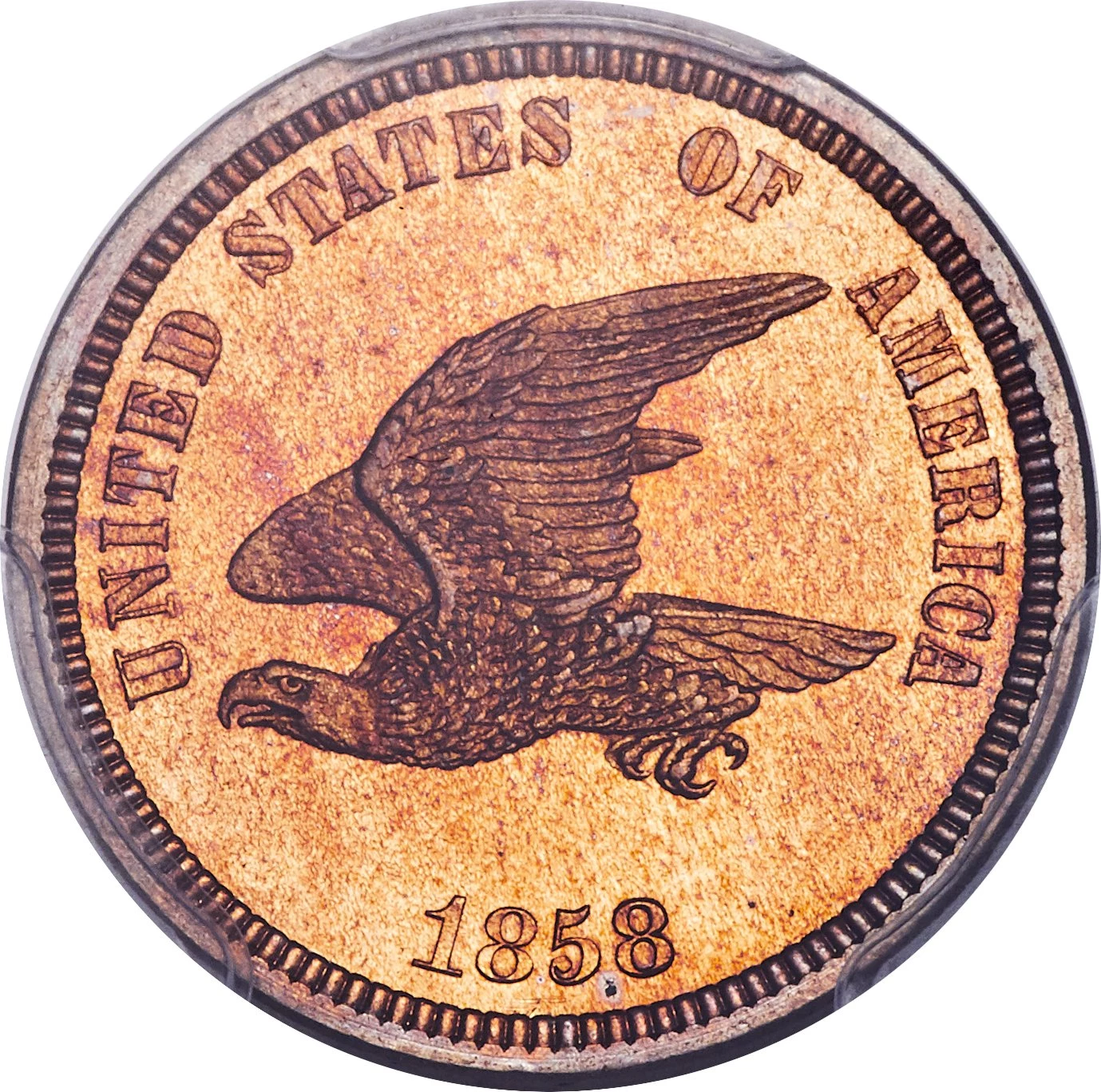






 Loading more ...
Loading more ...









